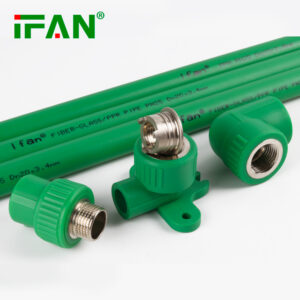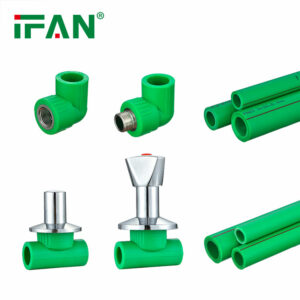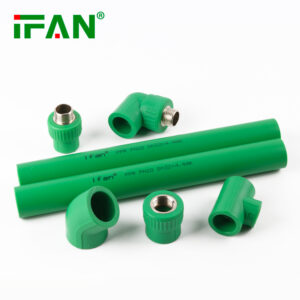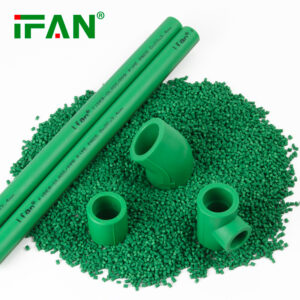
ASTM F2389 Innovative Designs in PPR Fittings for Energy-Efficient Plumbing
Whatsapp Us
Share
Description
IFAN factory 30+ years manufacture experience support color /size customization support free sample.Welcome to consult for catalog and free samples.This is our Facebook Website:www.facebook.com,Click to watch IFAN’s product video.Compared with Tomex products, our IFAN products from quality to price are your best choice, welcome to buy!
Innovative Designs in PPR Fittings for Energy-Efficient Plumbing
PPR (Polypropylene Random Copolymer) fittings have become a cornerstone in modern plumbing systems due to their durability, versatility, and cost-effectiveness. With an increasing demand for energy-efficient solutions in the construction and plumbing industries, PPR fittings are evolving to meet these needs. This article will explore the innovative designs in PPR fittings and how they contribute to energy-efficient plumbing systems.
What Are PPR Fittings?
PPR fittings are made from polypropylene, a type of thermoplastic polymer known for its strength and resistance to heat and chemicals. These fittings are widely used in both residential and commercial plumbing applications, connecting pipes in systems designed for water distribution, heating, and cooling. Their popularity has grown due to their ability to withstand high pressures, temperatures, and the wear and tear typical in plumbing systems.
PPR fittings are often favored over other materials such as PVC and metal due to their resistance to corrosion, ease of installation, and long lifespan. As more focus is placed on sustainable plumbing solutions, these fittings are being engineered to promote energy efficiency.
Energy Efficiency in Plumbing Systems
Energy efficiency in plumbing is achieved through several factors: reducing water and energy waste, optimizing heat distribution, and ensuring the longevity of the system. Traditional plumbing systems, especially those made of metal or PVC, can lose heat or allow for leaks, leading to inefficiencies and increased energy consumption. Innovative PPR fittings address these issues and provide a range of solutions designed to minimize energy loss and reduce the overall environmental impact of plumbing systems.
Innovative Designs in PPR Fittings for Energy Efficiency
1. Insulated PPR Fittings
One of the latest innovations in PPR fitting design is the development of insulated PPR fittings. These fittings are equipped with a layer of insulation, which helps to prevent heat loss in hot water systems. By maintaining water temperature over long distances, insulated PPR fittings contribute to reduced energy consumption. They are particularly useful in district heating systems, where long stretches of pipe are required to carry hot water to various buildings.
2. Smart PPR Fittings with Flow Regulation
Another breakthrough is the integration of smart technology into PPR fittings. These fittings can regulate water flow and pressure, ensuring that the plumbing system operates at optimal efficiency. Smart PPR fittings can automatically adjust to the water demand, avoiding unnecessary energy waste when water usage is low. This innovation not only enhances energy efficiency but also provides users with greater control over their plumbing systems.
3. Advanced Connection Techniques
Traditional plumbing systems often involve the use of threaded or welded joints, which can result in leaks or inefficient connections. PPR fittings, however, utilize heat fusion welding to create a seamless connection between pipes and fittings. This method ensures that the joints are leak-proof and reduces the risk of energy loss due to leaks or poor connections. The stronger, leak-free joints also contribute to the overall longevity and energy efficiency of the plumbing system.
4. Optimized Fitting Shapes
The design of PPR fittings has evolved to include more streamlined and optimized shapes that reduce resistance to water flow. These designs minimize turbulence and friction, ensuring that water moves smoothly through the system. The less friction there is, the less energy is required to pump water through the pipes. This reduction in friction can be especially beneficial in larger systems where water needs to be moved over long distances.
5. PPR Fittings with Antimicrobial Properties
Some manufacturers are now incorporating antimicrobial properties into PPR fittings. These fittings reduce the buildup of bacteria and other microorganisms, ensuring cleaner water and reducing the need for energy-consuming filtration systems. By maintaining high water quality, these fittings contribute to energy-efficient systems that require less maintenance and fewer resources to keep them functioning optimally.
Advantages of Using Energy-Efficient PPR Fittings
The shift toward energy-efficient PPR fittings brings several key advantages:
– Reduced Energy Bills: By reducing heat loss and improving the efficiency of water transport, energy-efficient PPR fittings help to lower heating costs. This is particularly significant in systems that rely on hot water, such as underfloor heating or central heating systems.
– Sustainability: PPR fittings are environmentally friendly because they are durable, long-lasting, and recyclable. Additionally, the energy savings achieved by using these fittings contribute to a more sustainable plumbing system overall.
– Low Maintenance: The durability of PPR fittings means that they require less maintenance over time. This reduces the need for costly repairs and replacements, which ultimately saves both energy and resources.
– Improved Performance**: Energy-efficient PPR fittings help to ensure that plumbing systems operate at peak performance, with fewer disruptions and a lower likelihood of costly failures.
PPR Fittings in Residential and Commercial Applications
In residential applications, PPR fittings are used in a variety of systems, including water distribution, underfloor heating, and even cooling systems. The integration of energy-efficient PPR fittings ensures that hot water remains at the desired temperature for longer periods, minimizing energy loss. These fittings are also ideal for systems that require a high level of durability and resistance to wear and tear.
In commercial applications, such as district heating systems or large-scale industrial operations, PPR fittings play a critical role in optimizing energy use. With the ability to regulate flow and reduce heat loss, these fittings help commercial buildings reduce energy consumption, resulting in lower operational costs and a smaller carbon footprint.
Conclusion
Innovative designs in PPR fittings are revolutionizing the plumbing industry by providing energy-efficient solutions that enhance both the performance and sustainability of plumbing systems. From insulated fittings to smart flow regulation and optimized fitting shapes, these developments help to minimize energy consumption, reduce maintenance costs, and extend the lifespan of plumbing systems. As the demand for sustainable solutions grows, the use of energy-efficient PPR fittings will continue to rise, making them an essential component in the evolution of modern plumbing.
FAQs
1. What are the main benefits of using PPR fittings in plumbing?
PPR fittings are durable, resistant to corrosion, and have a long lifespan. They are also leak-proof and can withstand high pressures and temperatures, making them ideal for various plumbing applications.
2. Can PPR fittings help reduce energy consumption in plumbing systems?
Yes, PPR fittings can help reduce energy consumption by preventing heat loss in hot water systems, optimizing water flow, and using smart flow regulation to avoid waste.
3. Are PPR fittings suitable for both residential and commercial plumbing?
Yes, PPR fittings are versatile and are used in both residential and commercial plumbing systems, including hot and cold water distribution, heating systems, and cooling systems.
4. How do insulated PPR fittings contribute to energy efficiency?
Insulated PPR fittings prevent heat loss from hot water systems, maintaining water temperature over long distances, which reduces the need for additional energy to reheat the water.
5. Do PPR fittings require a lot of maintenance?
PPR fittings require minimal maintenance due to their durability and resistance to corrosion. Their long lifespan and leak-proof connections help reduce the need for repairs and replacements.
Related products
-
PPR Fittings
Green PPR Plastic Material Fittings
-
PPR Fittings
PPR Fittings
-
PPR Fittings
IFAN PPR Fittings
-
PPR Fittings
What is the PPR Fittings








